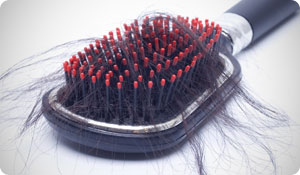
Typically, baldness is thought of as a problem that rests solely in the male population. While losing what was once a triumphant head of hair is more common in men, women actually make up approximately 40 percent of American hair loss sufferers. Although the hair loss patterns for men and women are a bit different, many of the causes and treatment methods are the same.
Female Pattern Baldness vs. Male Pattern Baldness
The pattern of baldness tends to be the same in the vast majority of men. Hair loss can start any time after puberty, usually in the late teens to early 20's. Typical male pattern hair loss starts as a recession of the hairline with some thinning in the crown. This could progress into complete baldness or the absence of hair at the top of the head.
In general, women tend to see a slightly different pattern and different time of onset of hair loss. Female pattern hair loss starts in the late 40's to 50's, usually without a recession of the hairline. Some women experience a thinning of density on the top of their head, and others tend to thin out over broader regions or the entire scalp.
What Causes Hair Loss?
1. Genetics and hormones play a large role for men and for women. According to American Hair Loss Association (AHLA), if you're experiencing male or female pattern baldness, you've actually inherited hair follicles that have a genetic sensitivity to the dihydrotestosterone (DHT), a derivative or by-product of testosterone.
Hair follicles sensitive to DHT begin to get smaller, which cuts the lifespan of each hair follicle short. Eventually, these affected follicles stop producing normal hair growth.
2. Alopecia areata is a rare autoimmune condition that causes hair loss. It targets just the scalp, or your entire body (alopecia universalis). The National Alopecia Areata Foundation explains that in all forms of alopecia areata, a person's hair follicles remain alive and are ready to resume normal hair production whenever they receive the appropriate signal. In nearly all instances, a person's hair could regrow without any form of treatment.
3. Some illnesses or diseases can contribute to baldness. In fact, the American Academy of Dermatology (AAD) states that telogen effluvium, a condition characterized by when an illness, stress, or some diseases pushes too many hairs into the resting phase of the hair growth cycle leading to a dramatic increase in hair shedding, is responsible of many cases of baldness that takes place later in life.
Some causes of telogen effluvium include:
- Antidepressants
- Chronic stress
- Major surgery
- A diet deficiency
- Flu associated with high fevers
- Low iron levels
4. Anagen effluvium is unique from telogen effluvium because it is caused by sudden disturbances to the matrix cells of the hair follicles. Instead of shedding, the hair is lost by the fracturing of the hair shafts at the level of the scalp. The two most common causes of anagen effluvium occur from cancer chemotherapy and from radiation therapy.
5. Women with polycystic ovary syndrome (PCOS) or those going through menopause experience excessively high levels of androgens (male hormones). Women with high or increasing levels of androgens may find that the hair on the head is thinned, while facial hair is coarser.
Additionally many women with PCOS also have thyroid problems, usually hypothyroidism (low thyroid function). This can also contribute to hair thinning.
What You Can Do
Some causes are unavoidable—a genetic predisposition or if you're going through chemo, for instance. However, you can take steps to avoid the loss of your luscious locks.
1. Pay attention to your diet or any deficiencies you may have. Hair is primarily made of protein and, therefore, it makes sense to eat a protein-rich diet if you're trying to maintain your healthy hair. Make sure you're diet consists of a regular intake of lean proteins, such as chicken, lean beef, and cold water fish.
Additionally, some women may experience hair loss due to an iron deficiency. Some iron-rich foods include:
- Clams
- Chickpeas
- Black beans
- Turkey breast
- Tofu
- Whole wheat bread
2. Take note of your grooming habits. Braiding, tight ponytails, and extensions can cause traction alopecia, which happens when trauma to the hair follicles over time results in hair loss. Some believe that wearing hats too frequently may also contribute to traction alopecia.
3. Get a hormone test. Catching any hormone issue early is key to preventing hair loss. A doctor could prescribe you hormone replacement therapy or oral contraceptives to help regulate your any abnormal estrogen or testosterone levels.





